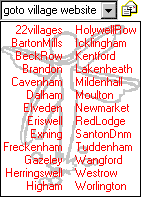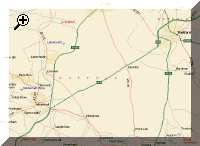




| |
- A Misplaced Suffolk Village (continued...)
 In the Domesday Survey there is an entry for Great Livermere in Thedwastre
Hundred which gives a list of the various holders of land (under Bury Abbey) and
ends with a statement of its area and its geld (f. 363b). Another entry gives
similar Information for Little Livermere in Blackburne Hundred (also under Bury
Abbey) and this also ends with a statement of its area and 1 .s geld In the Domesday Survey there is an entry for Great Livermere in Thedwastre
Hundred which gives a list of the various holders of land (under Bury Abbey) and
ends with a statement of its area and its geld (f. 363b). Another entry gives
similar Information for Little Livermere in Blackburne Hundred (also under Bury
Abbey) and this also ends with a statement of its area and 1 .s geld .
In addition there are three entries for a third Livermere, in Lackford Hundred,
and these give similar information including, again, a statement of area and
geld .
In addition there are three entries for a third Livermere, in Lackford Hundred,
and these give similar information including, again, a statement of area and
geld . Although these
entries clearly refer to a third Livermere, modern local historians, without
quoting any evidence, have applied them to the other two, even though Great and
Little Livermere are three miles 'distant from the nearest point of Lackford
Hundred. They have had to imagine a detached portion of Lackford Hundred
embedded in Thedwastre and Blackburne. This has been in spite of plentiful
evidence that there was, all through the Middle Ages and down to modern times,
an area called Livermere lying between Brandon (belonging, to Ely) and Wangford
(belonging to Bury), right in the middle of Lackford Hundred. Certainly there
is, as yet,' no archaeological evidence for a village there, and perhaps there
never was a nucleated one. . Although these
entries clearly refer to a third Livermere, modern local historians, without
quoting any evidence, have applied them to the other two, even though Great and
Little Livermere are three miles 'distant from the nearest point of Lackford
Hundred. They have had to imagine a detached portion of Lackford Hundred
embedded in Thedwastre and Blackburne. This has been in spite of plentiful
evidence that there was, all through the Middle Ages and down to modern times,
an area called Livermere lying between Brandon (belonging, to Ely) and Wangford
(belonging to Bury), right in the middle of Lackford Hundred. Certainly there
is, as yet,' no archaeological evidence for a village there, and perhaps there
never was a nucleated one.
Although 'there 'are three entries for Liverrnere In Lackford Hundred In
Domesday,' two of them are very small.
 | Bury Abbey's entry is for 2 freemen, 1 bordar,' 20 acres of land and a
half-plough (f. 358b), the same small numbers being repeated in the
contemporary Feudal Book' of Abbot. Baldwin ' ' |
 | Ely Abbey's entry is only for 3 freemen, 29 acres and another half-plough .
It is' significant that whereas Domesday heads this entry "In
Livermere", Inquisitio Eliensis adds "and in Wangford". .
It is' significant that whereas Domesday heads this entry "In
Livermere", Inquisitio Eliensis adds "and in Wangford". |
 | The third entry, Hugh de Montfort's, is much more considerable: under Hugh
de Beverda were 4 villeins, 3 bordars and 1 serf on a manor of two carucates;
there were also 3 freemen with 80 acres. Between all these there were 6
ploughs, and the area Is given as six furlongs by four, and the geld as 4d .
It is significant that this 4d, together with the 6d geld paid by
neighbouring Wangford, make up 10d which is half the 20d paid by so many
larger communities. .
It is significant that this 4d, together with the 6d geld paid by
neighbouring Wangford, make up 10d which is half the 20d paid by so many
larger communities. |
In Domesday it is recorded that Hugh de Montfort's estate had formerly been
held by Guthmund, who had obtained it from his brother, Wulfrlc, abbot of Ely.
Guthmund wished to marry Earl Aelfgar's daughter, but had to acquire land before
he could do so .
So the estate was lost to the abbey. It is clear from early charters that at
Ely, Livermere was regarded as some sort of appendage to their important manor
of Brandon, for eight small land transactions dated before the Conquest are
recorded in Liber Eliensis as "in Brandon and Llvermere" .
So the estate was lost to the abbey. It is clear from early charters that at
Ely, Livermere was regarded as some sort of appendage to their important manor
of Brandon, for eight small land transactions dated before the Conquest are
recorded in Liber Eliensis as "in Brandon and Llvermere" . .
It Is not known when the bishopric of Ely recovered the two carucates in
Livermere which had been lost to Hugh de Montfort. However, in the survey of the
bishop's manors made in 1222 amongst the freemen holding of the manor of Brandon appears Gervase de Wangford
who held one carucate in Llvermere for 3s. 2d. and boon-tasks. What else could
this be but one of Hugh de Montfort's two carucates? So, in the first quarter of
the thirteenth century Livermere was still, in some sense, a recognized entity.
However,, in the survey of 1251
amongst the freemen holding of the manor of Brandon appears Gervase de Wangford
who held one carucate in Llvermere for 3s. 2d. and boon-tasks. What else could
this be but one of Hugh de Montfort's two carucates? So, in the first quarter of
the thirteenth century Livermere was still, in some sense, a recognized entity.
However,, in the survey of 1251 this same carucate "which was Gervase de Wangford's", now held by
Simon and Adam Bolt, was no longer specifically stated to be in Livermere. In
both surveys the entry for this carucate, coming almost at the end of the
freemen's holdings, is separated from them by an entry for 3 messuages held of
Brandon manor' In Thetford. Again, in both surveys, following the Livermere
carucate, comes an entry for another whole carucate, held for the same rent and
services as the former. It seems likely that this second carucate was the second
of Hugh de Montfort. ' In the 1222 survey there is also a second entry for land
stated to be in Livermere; in the short financial summary for Brandon manor at
the end of the survey, is an item for 4s. for pasture, at the bishop's disposal,
in Livermere.
this same carucate "which was Gervase de Wangford's", now held by
Simon and Adam Bolt, was no longer specifically stated to be in Livermere. In
both surveys the entry for this carucate, coming almost at the end of the
freemen's holdings, is separated from them by an entry for 3 messuages held of
Brandon manor' In Thetford. Again, in both surveys, following the Livermere
carucate, comes an entry for another whole carucate, held for the same rent and
services as the former. It seems likely that this second carucate was the second
of Hugh de Montfort. ' In the 1222 survey there is also a second entry for land
stated to be in Livermere; in the short financial summary for Brandon manor at
the end of the survey, is an item for 4s. for pasture, at the bishop's disposal,
in Livermere.
The later history of half Gervase de Wangford's carucate, 60 acres, which
came into the hands of Langley Abbey, can be traced down to modern times, and
the area in which it lay is certain, In the Brandon manor court roll for March
1330 the abbot of Langley is' ordered to be distrained for fealty and other services
for a holding which had been Simon Bolt's. In the Brandon manor compotus roll
for 1388-89
the abbot of Langley is' ordered to be distrained for fealty and other services
for a holding which had been Simon Bolt's. In the Brandon manor compotus roll
for 1388-89 appears
"In lapsed rent for 60 acres of free-land which the abbot of Langley
formerly held and is now in the lord's hands because not tilled owing to
devastation by coneys, is. 7d. for the year". So Langley Abbey held half
Gervase de Wangford's curucate in Livermere for half the rent of the whole.
Moving on to more modern times, during a lawsuit in 1612 appears
"In lapsed rent for 60 acres of free-land which the abbot of Langley
formerly held and is now in the lord's hands because not tilled owing to
devastation by coneys, is. 7d. for the year". So Langley Abbey held half
Gervase de Wangford's curucate in Livermere for half the rent of the whole.
Moving on to more modern times, during a lawsuit in 1612 an eighty-year-old witness, John Basely, said that he had heard that there were
lands called Langley Roods, all in Livermere Field, and that he thought that
they lay amongst the other roods in that field. The subject of the lawsuit was
the ownership of the coneys which escaped from Brandon warren into Livermere
Field, so the lands which had belonged to Langley Abbey were still invaded by
rabbits. A generation later, in 1644, amongst lands in Brandon conveyed by
William Plesaunce to Robert Wright were 60 acres of land called "Langley
lands or Langley Roods lying or supposed to lie in Livermere Field"
an eighty-year-old witness, John Basely, said that he had heard that there were
lands called Langley Roods, all in Livermere Field, and that he thought that
they lay amongst the other roods in that field. The subject of the lawsuit was
the ownership of the coneys which escaped from Brandon warren into Livermere
Field, so the lands which had belonged to Langley Abbey were still invaded by
rabbits. A generation later, in 1644, amongst lands in Brandon conveyed by
William Plesaunce to Robert Wright were 60 acres of land called "Langley
lands or Langley Roods lying or supposed to lie in Livermere Field" .
Both in the lawsuit and in the conveyance it is taken for granted that (at that
time) Livermere Field was in Brandon Parish, though it was not one of the
age-old nine fields of Brandon Field. On the 1809 enclosure map, Livermere Field
is shown as about 360 acres lying on the Brandon side of the Brandon-Wangford
boundary, and stretching from the eastern side of Shakers Road, westwards to
within three-quarters of a mile from the present A 1065. During the 1612 lawsuit
another witness said he had seen "an original lease" made by an abbot
of Langley in the possession of John Capp, deceased, which mentioned all the
lands of the abbey in Brandon and in Wangford as well, the latter including a
close and a "Langley Acre" in Wangford Field. .
Both in the lawsuit and in the conveyance it is taken for granted that (at that
time) Livermere Field was in Brandon Parish, though it was not one of the
age-old nine fields of Brandon Field. On the 1809 enclosure map, Livermere Field
is shown as about 360 acres lying on the Brandon side of the Brandon-Wangford
boundary, and stretching from the eastern side of Shakers Road, westwards to
within three-quarters of a mile from the present A 1065. During the 1612 lawsuit
another witness said he had seen "an original lease" made by an abbot
of Langley in the possession of John Capp, deceased, which mentioned all the
lands of the abbey in Brandon and in Wangford as well, the latter including a
close and a "Langley Acre" in Wangford Field.
Richard I was said to have confirmed the grant of Livermere Grange to Warden
Abbey .
There seems to be no surviving evidence as to who made the original grant, or
whether it was more than a message with an attached sheep-right with pasture
upon the heathland. Later it became of considerable value as is indicated by the
statement in the Red 'Book of the Exchequer that in the time of Henry III the
abbot of Warden held one fee in Llvermere and Wangford (xiii). At the great
Inquisition held at the beginning of Edward I's reign, the rolls say that the
abbot of Warden had withdrawn his suit to Lackford Hundred which he owed for his
holding in Livermere and Wangford, "and has done so for the past eight
years"; still in 1393 the then abbot was paying 2s. fine for suit to the
hundred which he owed for his Livermere Grant .
There seems to be no surviving evidence as to who made the original grant, or
whether it was more than a message with an attached sheep-right with pasture
upon the heathland. Later it became of considerable value as is indicated by the
statement in the Red 'Book of the Exchequer that in the time of Henry III the
abbot of Warden held one fee in Llvermere and Wangford (xiii). At the great
Inquisition held at the beginning of Edward I's reign, the rolls say that the
abbot of Warden had withdrawn his suit to Lackford Hundred which he owed for his
holding in Livermere and Wangford, "and has done so for the past eight
years"; still in 1393 the then abbot was paying 2s. fine for suit to the
hundred which he owed for his Livermere Grant ,
and in 1386 John Manys, "the abbot of Warden's man" o was amerced for
bringing sheep to feed on Brandon common pasture ,
and in 1386 John Manys, "the abbot of Warden's man" o was amerced for
bringing sheep to feed on Brandon common pasture . .
by J.T. Munday © Mildenhall Museum
|

![]()
